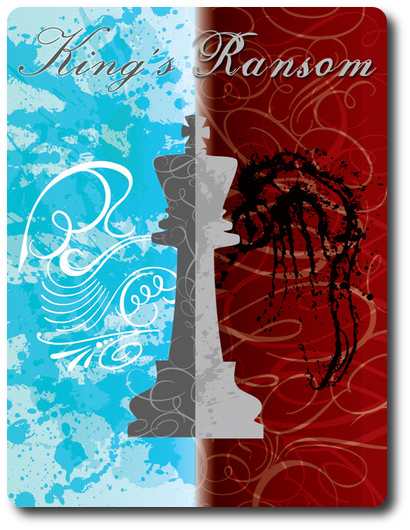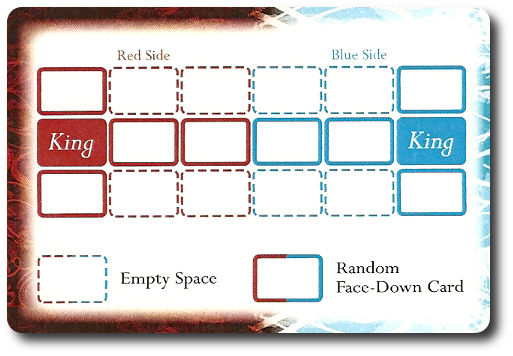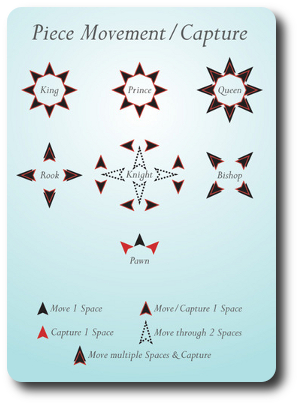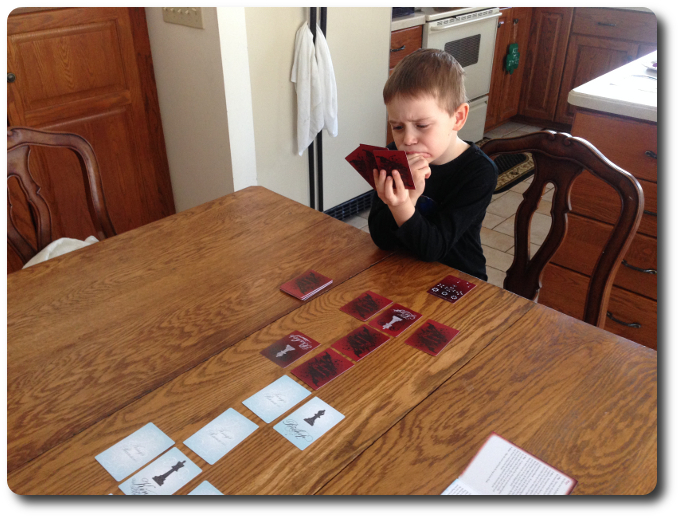
The Basics:
- For ages 6 and up (publisher suggests 13+)
- For 2 players
- Approximately 15 minutes to complete
Geek Skills:
- Counting & Math
- Logical & Critical Decision Making
- Reading
- Memorization
- Strategy & Tactics
- Risk vs. Reward
- Visuospatial Skills
- Hand/Resource Management
- Bluffing and Misdirection
Learning Curve:
- Child – Easy
- Adult – Easy
Theme & Narrative:
- Capture the king in this card game Chess variant
Endorsements:
- Gamer Geek mixed!
- Parent Geek approved!
- Child Geek approved!
Overview
Chess is a game that fills some with dread, some with boredom, and many with excitement. It’s a game played around the world, in grade schools, playgrounds, and in homes by the young and old alike. Cards and card games are even more popular and are much less intimidating. You are more likely to play a card game than a Chess game on any given occasion. Imagine if you could blend Chess and cards together. Would get something made of elements that represent the best of both games or something entirely different? Let’s find out.
King’s Ransom, designed by Frank Zazanis and published by General Nonsense Games, is comprised of 24 blue Piece cards, 24 red Piece cards, and 2 Piece Movement/Capture reference cards (1 blue, 1 red). The cards are as thick as your common playing card. The card artwork quietly suggests an angelic and demonic theme (good versus evil), but it’s only so much window-dressing.
Game Set Up
To set up the game, first separate the cards into two different colored decks (red and blue). Give one player the red deck and one player the blue deck.
Second, each player finds and removes the “King” Piece card and the Piece Movement/Capture reference card. The remaining cards should be shuffled together to form the player’s deck.
Third , each player sets their Piece Movement/Capture reference card to one side of their playing area and both players should sit so that they are facing each other (as you would in a traditional Chess game).
Fourth, each player places their “King” Piece card in front of them, face-up, and then draws an additional 4 Piece cards from their deck. These are place around the “King” Piece card, face-down, as shown in the below image. The remaining cards in the player’s deck remain face-down and to one side of the player. Each player should leave room next to their deck for a discard pile.

Fifth, each player should draw 3 Piece cards from their deck to create their initial hand.
This completes game set up. The player with the red Piece deck goes first.
To Capture a King
If you are familiar with traditional Chess, King’s Ransom will come easy. However, King’s Ransom is best described as being based off of Chess. It’s not Chess with cards, as many might incorrectly assume. The game is a hodgepodge of Chess variants that is played on a 3 x 6 grid playing area using cards.
Like Chess, the game is played in turns with no set number of turns per game. On a player’s turn, they will complete the following steps:
Step 1: Flip a Piece Card
If the player has a face-down Piece card in play, it must be flipped over and revealed at this time. If the player has more than one, they can decide which card to flip and reveal.
Step 2: Move and Capture Piece Cards
The player must now move one of their face-up cards using the piece’s movement rules. If the Piece movement allows it to land on a space occupied by their opponent’s Piece card (regardless if it’s face-up or face-down), it’s captured. Captured Piece cards are removed and placed in their owning player’s discard pile. The below image explains all the movement and capture rules for the Piece cards in the game.

Step 3: Announce Check
If any face-up Piece card is threatening the opponent’s “King” Piece card, the player must announce it by stating “Check”. This indicates that the player can capture their opponent’s King if action is not taken by the opponent to prevent it.
Step 4: Play
The player can now select any card from their hand and play it, face-down, in any free space on their side of the playing area.
Step 5: Draw 1 Piece Card
The final step a player takes on their turn is to draw 1 Piece card from their deck, bringing their hand to a total of 3.
This completest the player’s turn. The next player now takes their turn completing the steps above.
Check and Mate
If a player is able to capture their opponent’s “King” piece card either by moving a card on their turn or ending their turn and leaving their opponent’s “King” Piece card in a checkmate, they win. “Checkmate” means that whatever action the player can possibly think of on their turn, it will not save their “King” Piece from being captured or puts their “King” in danger of being captured. Note that putting an opponent in check or checkmate can occur during Piece card movement and when revealing a face-down Piece card.
To learn more about King’s Ransom, visit the publisher’s website.
Prediction
Most of the players in my groups enjoy Chess or, at the very least, tolerate it. Chess is considered by many to be an “old game” or “too difficult”. While I agree that Chess is no longer the new hotness, it’s far from being difficult. There are a growing number of card, board, and dice games that I would consider much more involved and intellectually intensive to learn.
That being said, King’s Ransom is going to be an easy Abstract Strategy game to teach and to grasp. Any players we have that are not familiar with Chess will have no problem learning how to play this very straightforward Chess variant. The rules are very thin, offering just enough to make sure everyone knows how to play, and leaves out any additional details regarding strategy and tactics. Luck does play a role in this game, as does memory, since cards are first randomly dealt to create the first pieces and then players play additional pieces face-down. Remembering what pieces have been played will help any player, but will not guarantee them victory. I have no doubt King’s Ransom will be enjoyed by the Child Geeks, smiled upon by the Parent Geeks, and tolerated by our Gamer Geeks. Especially those who really enjoy a good Chess game.
King’s Ransom is a game best taught by example. Demonstrate how the Piece cards move and make sure to point out how movement and capturing is explained on the Piece Movement/Capture reference cards. All the information a player will need is clearly detailed on the reference card and should be kept handy at all times. Note that younger Child Geeks who have played Chess before, but cannot read, will have a hard time at first identifying game pieces by their image on the Piece cards. Until the younger Child Geeks can recognize all the pieces, I suggest an adult or an older player be available to quietly read the name of the Piece cards to the younger player.
And so, after teaching the game to my two oldest little geeks, I asked them their thoughts on King’s Ransom so far.
“I like how it’s Chess with cards. I guess that means you can play it pretty much anywhere.” ~ Liam (age 9)
“I don’t know yet. I have to play it to decide.” ~ Nyhus (age 6)
My oldest only sees a Chess variant, while his younger brother doesn’t know what he is looking at. Excellent. It’s always good to have a healthy mix of opinions prior to playing a game. Let’s play King’s Ransom and see if it’s a game worth getting excited about or one that should be pawned.
Mmmm…delicious Chess puns….
Final Word
The Child Geeks had no problem learning how to play the game and playing it well. They quickly grasped how the cards moved and the benefits of playing some cards later. What was very pleasing to observe was how the Child Geeks set up their opponents. Much like how a player would lure an opponent under false pretenses of safety in Stratego, I saw my 6-year-old nonchalantly place a Queen in front of his opponent like it was no big deal. Next turn, he slaughtered him. Awesome. The only Child Geeks who had problems at first were those who couldn’t read very well. A Parent Geek looking over their shoulder fixed that without causing any problems with the game. According to one Child Geek, “This is better than Chess because you can set the board the way you want!” When all the games were done and the votes counted, King’s Ransom scored BIG with the Child Geeks.

My 6-year-old thinks hard about his next move…
The Parent Geeks also enjoyed the game a great deal, both with their family and with their peers. Since this is a 2-player only game, the Parent Geeks found it to be a fun way to spend some quality time with their child or with their significant other. Friends against friends also worked out. According to one Parent Geek, “This is a nicely designed and easy to play abstract game. I don’t know much about Chess, but this was a game I immediately understood and enjoyed.” All the Parent Geeks agreed, finding King’s Ransom to be a fun, engaging, and light game enjoyed by all.
The Gamer Geeks were less praiseworthy and much more critical. Which is exactly what you should expect from a group of gaming elitists. A few of them thought themselves excellent Chess players and scoffed at the notion that King’s Ransom was anything like Chess. According to one of these Gamer Geeks, “This isn’t Chess. This isn’t even close to Chess. This is a card game that uses Chess names, and that’s all.” I agreed and asked if that made it any less interesting. He answered it did not but it hardly made it more interesting, either. A fair point. Another Gamer Geek rather enjoyed himself and said, “It’s a good game, easy to learn, and can be played pretty quickly. I’d keep this game in my collection for a game filler.” When all the games were played, the Gamer Geeks had mixed feelings about King’s Ransom. All agreed it was an “alright game”, but few agreed it was a “Gamer Geek’s game”.
I wouldn’t recommend King’s Ransom as a teaching tool to learn Chess. There are similarities, to be sure, but not enough to lead me to believe that it sets a would-be Chess player on the right path. Rather, I think King’s Ransom is the perfect Chess game for those who don’t want to play Chess, but like the idea of playing Chess sometime in the future. Maybe. King’s Ransom is a hard game to nail down. Suggesting it’s “just a Chess variant” doesn’t do it justice and suggesting that it’s’ “Chess with cards” is inaccurate.
Let me come at it another way. If you are familiar with Knightmare Chess (one of my all-time favorite Chess variants), you know it’s a game that changes the rules of the Chess, but you still need to know how to play Chess to begin with. The same cannot be said about King’s Ransom. You don’t have to know the first thing about Chess to play this card game. Further more, knowing how to play Chess gives you no advantage over your opponent. A Grandmaster of Chess could lose to a 6-year-old novice who has the right cards. Unlikely, but possible.
So, where does that leave us and this card game that is based off of Chess, uses terms like Chess, but has little to do with Chess? In a unique place that feels very familiar, would be my answer. Once you do get it on the table, you’ll see it’s more than what it positions itself to be. Even our players who were not Chess enthusiasts enjoyed themselves. The Gamer Geeks who didn’t endorse the game did so simply because they thought there were better 2-player games available. Which, honestly, is a matter of opinion.
Do play a quick game of King’s Ransom if you enjoy 2-player games of strategic and tactical abstract play. It might just itch that Chess scratch you cannot reach.
This game was given to Father Geek as a review copy. Father Geek was not paid, bribed, wined, dined, or threatened in vain hopes of influencing this review. Such is the statuesque and legendary integrity of Father Geek.




Thanks for this review. King’s Ransom looks like another brilliant chess based game for kids. Our favorite is Story Time Chess, but we also like to play Chess Solitaire and No Stress Chess. The best thing about those games is that kids want to play the old, good Chess. Of course they need some practice and here, with a big help, comes Maksim Aksanov with Chess Puzzles book (net-boss org/chess-puzzles-for-kids-by-maksim-aksanov).
Thanks for taking the time to leave a note, Jane.
Yes, it does make the heart feel good to see a younger geek generation showing interest in Chess. There are many resources available – for free and for purchase – to teach and help Child Geeks get better at the game. My oldest son plays and makes it a point to beat me – repeatedly – during each of our games. He learned how to play from his parents, but got good by reading articles and watching videos.
Gone are the days of me forcing myself to play the 10th game of Shoots and Ladders…. That’s a good thing.